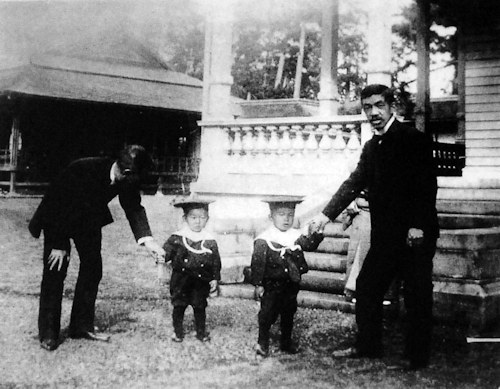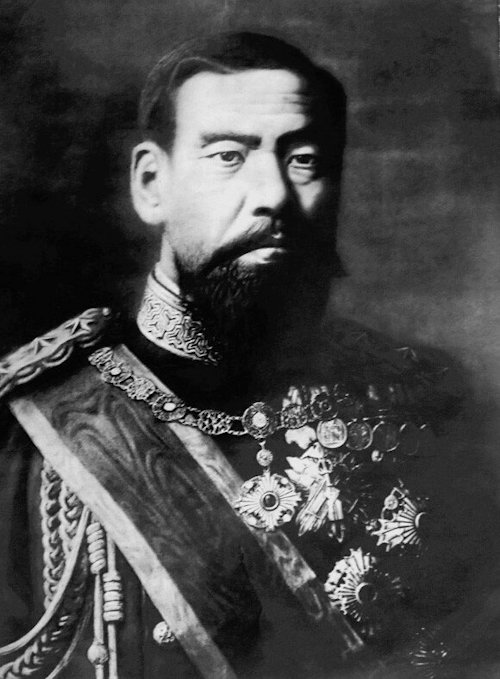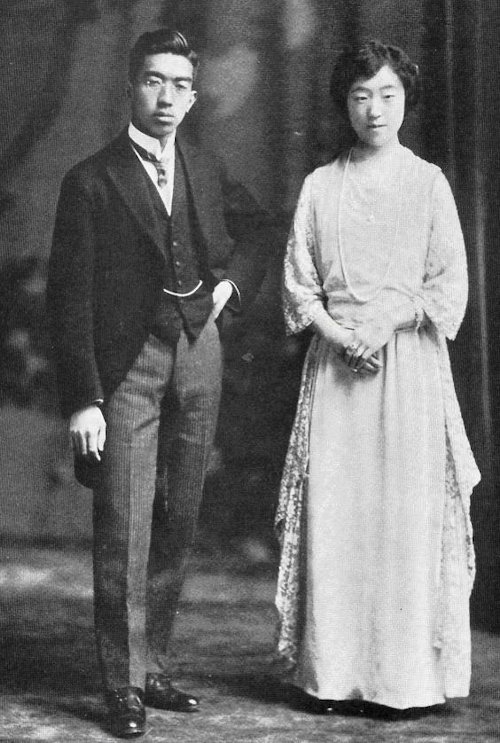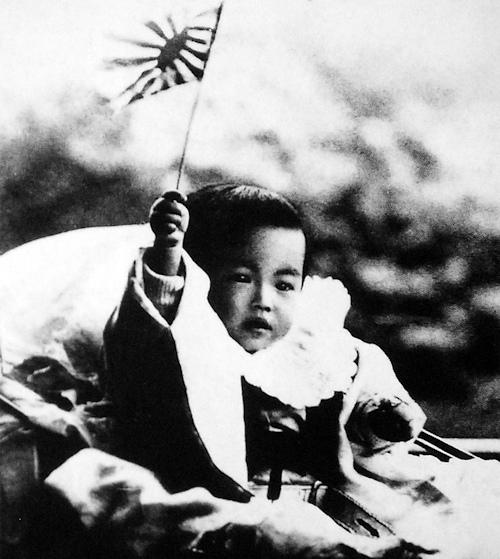For us westerners it is certainly difficult to admit that an entire people for two thousand six hundred years could seriously and unswervingly believe in the dogma of the direct affiliation of the imperial family and of Japan itself from a divine being, yet it happened. Only a people mythicized and exalted by a firm conviction of this species could, for example, change the face of his country in less than thirty years, between the 1870 and the 1900, making a leap for which at least Europe was necessary at least six centuries. True, there were Western models to copy, imitate, plunder and tamper with at will. In a few decades we have gone from the white weapon to the trellised turrets of the super-fenders, from the sedan chair to the airplane, it has been an absolutely unprecedented phenomenon and without subsequent examples all over the world, a limit case of character and vitality.
Japanese legends indicate in 600 BC the year in which Jimmu Tenno descendant of the goddess Amaterusa (Great goddess shining in the heavens), one of the main Shinto deities (Kami) Japanese word for spirit or deity, would have ascended the throne and founded the empire of the rising sun. According to this tradition, Japanese rulers have always been considered direct descendants of the gods.
More precise information is beginning to have between the 2nd and 5th century AD and concerns above all the populations settled in the southern part of the archipelago which, due to its greater proximity to the already evolved Korea and China, is more directly affected by its civilizing influence. In these regions, and more precisely in the island of Kyushu, the southernmost of the great Japanese islands, at the beginning of the 5th century a clan of the most powerful elevated its head to the rank of supreme emperor and began the slow establishment of a state centralized on the Chinese model. With the reform of the era "Taikwa or Taika"(645-650 AD) was an important political-administrative reform carried out in Japan by the emperor Kotoku (596 – 654) was the 36 emperor of Japan according to the traditional succession order.
First-born Hirohito of Crown Prince Yoshihito (1879-1926) and his consort Sadako, the 29 April 1901 was born in Tokyo. The name of Hirohito is composed of two ideograms; the first "Hiro"Means:" Great, generous, kind ". The second one "Milestone"Means:"Perfect virtue, benevolence, humanity". So the whole name can be rendered with expressions like: "Great humanity, generous benevolence, supreme virtue".

His father, son of the great emperor Meiji (1852-1912) and a concubine, did not enjoy good health and not yet fifty years old, he will die mad. Hirohito, on the other hand, although he was very frail at birth, would have grown healthy in body and mind. Still in swaddling clothes, he was entrusted to Count Kawamura, vice-admiral of the Imperial Navy, who arranged for him to be reared in his own villa at Azabu, and only in the 1894 he was readmitted to the residence of the crown prince, the palace of Akasaka. This precaution of removing the heir to the throne from the court went back to an ancient tradition.
In past centuries the pregnant of a possible heir or the heir to the imperial throne could remain victims of apparently causal or accidental deaths. In the case of Hirohito, the removal probably saved him from the epidemics of typhus, smallpox and dysentery that periodically swept the paternal palace, and it was considered sacrilege that a doctor's hands or instruments touched the sacred person of a crown prince. Formerly this custom of separating the sons of the emperors immediately after birth, entrusting them to the care of severe processors, was above all a considered political measure of the Shogun which aimed to totally isolate the emperor even from his closest relatives, intended to prevent any possible attempt by the emperors to achieve effective power over the country. Thus there were no bonds of any kind between the emperor and the princes, much less sentiments of affection. It was a drastic system to prevent father and son from conspiring together against those who actually held power. Only at the beginning of the twentieth century with the emperor Meiji these rules relaxed, but did not disappear.
The young Hirohito was inculcated in the consciousness of the future that awaited him: he would have been the divine sovereign of the people favored by the gods. At the age of seven he began attending the Gakushin school, founded, at the behest of Emperor Ninko, in the 1847 in Kyoto as a center of studies for the young of the imperial court and imperial families. In the 1877 he was transferred to Tokyo, in the Toshima district. By this name we mean all the different schools opened over the years, which currently cover the entire cycle of studies from nursery school to university and masters or research doctorates. To these are also added the women's middle and high schools and the women's university. Reserved for the aristocrats who would rule the country headed by a national hero, Count Mareseku Nogi (1849-1912). Son of a samurai, during his career he managed to reach the top of the military hierarchy and was also given noble titles of Danshaku e hakushaku (equivalent to the baron and to the European count) due to his important victories in the first Sino-Japanese war and the Russo-Japanese war.
Twelve carefully chosen noble offspring attended the same class as the future emperor. The program was more complex than that of ordinary primary schools, but here too loyalty to the reigning ruler was inculcated. Every morning, in fact, after the one-minute bow in the direction of the palace, and the singing of the national anthem, lessons began.
 The 30 July 1912 the emperor grandfather (photo) died, had 60 years and had reigned for 45, ferrying Japan from a feudal era to the industrial era. On the eve of the funeral Nogi stayed with Hirohito for a few hours, questioning him about all the subjects of study, and finally satisfied, he gave him a book of Confucian precepts. The next day the young prince learned, dismayed but impassive that his adoptive father the count and general Nogi, to follow his emperor in the afterlife, according to an ancient rite, was done with his wife "Seppuku".
The 30 July 1912 the emperor grandfather (photo) died, had 60 years and had reigned for 45, ferrying Japan from a feudal era to the industrial era. On the eve of the funeral Nogi stayed with Hirohito for a few hours, questioning him about all the subjects of study, and finally satisfied, he gave him a book of Confucian precepts. The next day the young prince learned, dismayed but impassive that his adoptive father the count and general Nogi, to follow his emperor in the afterlife, according to an ancient rite, was done with his wife "Seppuku".
On Meiji's death, Yoshihito, the only survivor of twelve children, took the throne and took the name of "Taisho","Great Righteousness ". Two years later the First World War broke out in Europe and Japan allied with England, in August of 1914 declared war on Germany and occupied all German possessions in the Far East: in China and the Caroline Islands of the Marshalls and the Marianne .
In the meantime Hirohito finished his primary studies and started attending a course of studies under the guidance of another national hero; Admiral Heihachiro Togo (1848-1934) the destroyer of two Russian fleets during the 1904 / 05 war. The young prince showed interest and uncommon skills in geography, physics, mathematics, foreign languages and above all biology. Capturing insects, collecting flowers, studying them, cataloging them, under the guidance of his professor of natural sciences Hirotaro Hattori (1867-1941) was the favorite activity of the adolescent prince. A passion that will accompany him throughout his life, making the future emperor an expert on the subject.
The 3 November 1916 Hirohito was officially named crown prince, and according to tradition he received the two Samurai swords as a gift. The 3 March 1921 in admiral Hirohito's uniform embarked on Yokohama on the cruiser Katori that, escorted by the cruiser Kajima and from five destroyers, set sail for Europe. The team stopped in Okinawa, Hongkong, Singapore, Colombo, Port Said.
In Malta, the honors of the house were made by the Duke of York, the second son of the King of England and future ruler with the name of George VI (1895-1952). For the occasion, the Japanese prince witnessed the Othello performance given by an Italian company, it was the first time he entered a theater. The 8 in May the Japanese team was welcomed in Portsmouth by the Home Fleet and Hirohito received at Victoria station by King GeorgeV (1865-1936). At the end of May Hirohito visited France, then Belgium and Holland. Then he reached Toulon to embark for Naples, continuing by train to Rome where he was welcomed by Vittorio Emanuele III (1869-1947) and the 15 June entered the Vatican to be received by Pope Benedict XV (1854-1922). He visited Tivoli and Pompeii, then from the port of Naples he set sail for his return to Japan.
Never, in 2850 years, a member of the august dynasty had abandoned the Japanese archipelago. Of course Hirohito's visit to Europe and above all to England was for a very specific political purpose, to reconfirm and strengthen the Anglo-Japanese alliance treaty that had proved so useful for the interests of the Rising Sun in the Far East, since the war against the Russia of the 1904. But the interests of Great Britain now more closely matched those of the United States who did not look favorably on Japanese expansion in the Pacific and China. Under pressure from Washington, which hindered the Anglo-Japanese alliance, Great Britain preferred to strengthen the agreement with the United States and the alliance with Japan was denounced and the 13 declined in December of the same year.
 The 26 January 1924 was celebrated the marriage of Hirohito with Nagako (1903-2000), in the schism temple annexed to the imperial palace, and throughout the country echoed the cannons with joy. Two years later Emperor Yoshihito died in Hayamo's summer palace. The Hirohito regent officially ascended the imperial throne, becoming the one hundred and twenty-fourth emperor of Japan, choosing for his reign the appellative of "Showa", The two syllables"Sho e Wa"Were taken from a sentence in classical Chinese, which means"Illuminated Peace". With the'Mukden episode all of East Asia entered its labor period. The most dramatic phase of its history opened up and became a tragedy.
The 26 January 1924 was celebrated the marriage of Hirohito with Nagako (1903-2000), in the schism temple annexed to the imperial palace, and throughout the country echoed the cannons with joy. Two years later Emperor Yoshihito died in Hayamo's summer palace. The Hirohito regent officially ascended the imperial throne, becoming the one hundred and twenty-fourth emperor of Japan, choosing for his reign the appellative of "Showa", The two syllables"Sho e Wa"Were taken from a sentence in classical Chinese, which means"Illuminated Peace". With the'Mukden episode all of East Asia entered its labor period. The most dramatic phase of its history opened up and became a tragedy.
With the explosion of the 18 in September 1931, the chain of events that led to the mortal agony of the League of Nations, the invasion of China by Japan, the attack of Pearl Harbor, the invasion of all Asia began. East, the two atomic bombs and the defeat of Japan. Despite the unprecedented tragedy that had upset Japan, the figure of the emperor always kept first place in the feelings of the people, even in the most tragic moments.
At noon of the 15 August 1945 the whole of Japan holds its breath, schools, offices, factories are closed, the fields deserted; the trains were ordered to stop at the stations. Everyone was waiting to hear the emperor's voice, which they had never heard before. The radio announcer invited all listeners to stand up and all of Japan listened to Hirohito's voice. The Japanese plenipotentiaries signed the formal surrender document on the morning of the 2 September 1945 aboard the battleship Missouri anchored in Tokyo Bay.
Sacred respect for the emperor was evidently too rooted in the Japanese people, because even the new situation of humiliated and defeated Japan could tarnish it. The masters could in fact have been changed, but above all intangible, Hirohito remained.
I would like to mention a significant episode: several months after the end of the war and the announcement of the emperor who declared not to be divine and never to have been, an old farmer stopped in front of the building where MacArthur headquarters was located (1880-1964). First he bowed deeply before the American flag, then turned and just as deeply bowed in the direction of the imperial palace that was on the other side of the square. The old paid homage unreservedly to the temporal power of the Shogun, but at the same time revered the other power, the eternal power of the emperor.
The 7 January 1989 the emperor Hirohito died, and with his disappearance ended the era "Showa”, The longest in the history of Japan. Only after the announcement of his disappearance did the agency of the imperial house spread the causes of the death of the sovereign, which established that it was a glandular tumor of the digestive system. To honor the memory of the emperor, a state funeral was celebrated in the presence of many heads of state and government, and at the same time funeral ceremonies Shinto, officially not provided for by current laws.
REFERENCES
John Toland - the eclipse of the rising sun - Mondadori 1971
Tsunetomo Yamamoto, LV Arena- Hagakure. The samurai code - RCS MediaGroup 2006.
Roger Bersihan - History of Japan - 1961 Hats
Daniela De Palma - History of contemporary Japan, 1945-2000 - Rome, Bulzoni publisher, 2003.
Il Milione, vol. XII - De Agostini Geographic Institute of Novara 1967












